Mercer Family of Cowden
William Mercer of Cowden, Great Harwood, was buried on the 10 October 1613. His will stipulated that he wished to be buried ‘within the Chapell of Harwood as near to Elizabeth my wife as can be convenient.’ Elizabeth herself had been buried a mere eleven days before William on the 29 September 1613, which was also the day on which William made his will. We may never know why William and Elizabeth died within days of each other, but William did feel it prudent to settle his affairs on the day that his wife was buried.
Cowden is situated in a particularly pleasant position near to the Bowley area and to the east of Dean Lane. The farm, variously spelt as Cowden, Coulden, and Couden in documents, is one of the oldest in Great Harwood. A plan exists of the town made in 1603 and this shows that the land below Bowley and to the Calder was ‘held in severalty’, that is for the use of one person rather than held in common. The farm seems to have had about 60 statutory acres from at least the early eighteenth century (with some reduction, however, in the mid-nineteenth century) until 1980 when land was purchased from nearby Squires Farm increasing it then to 90 acres.
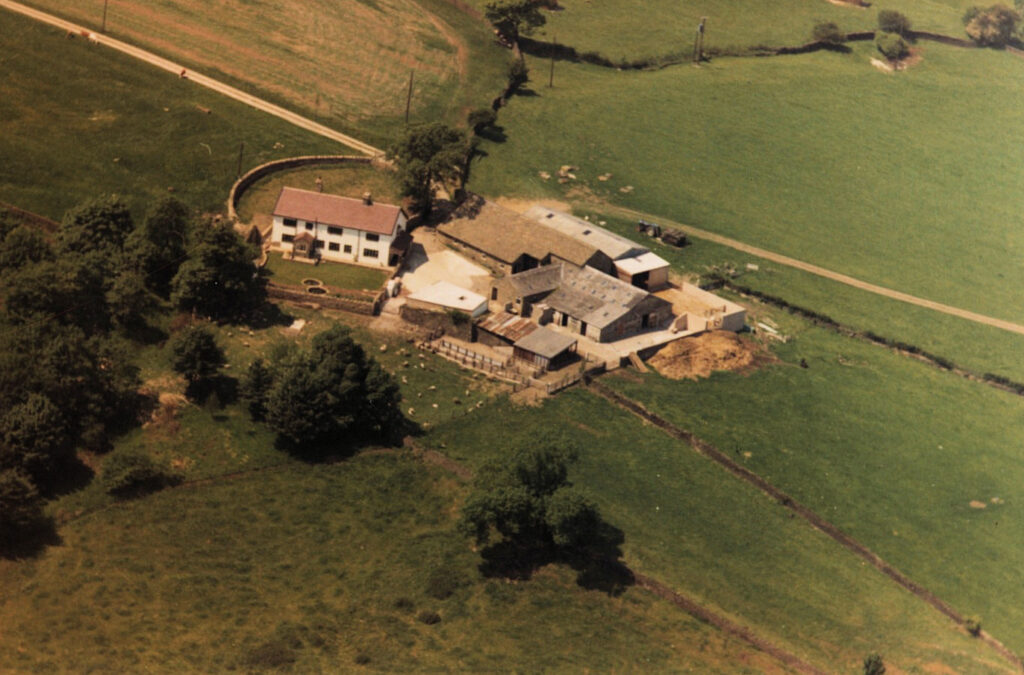
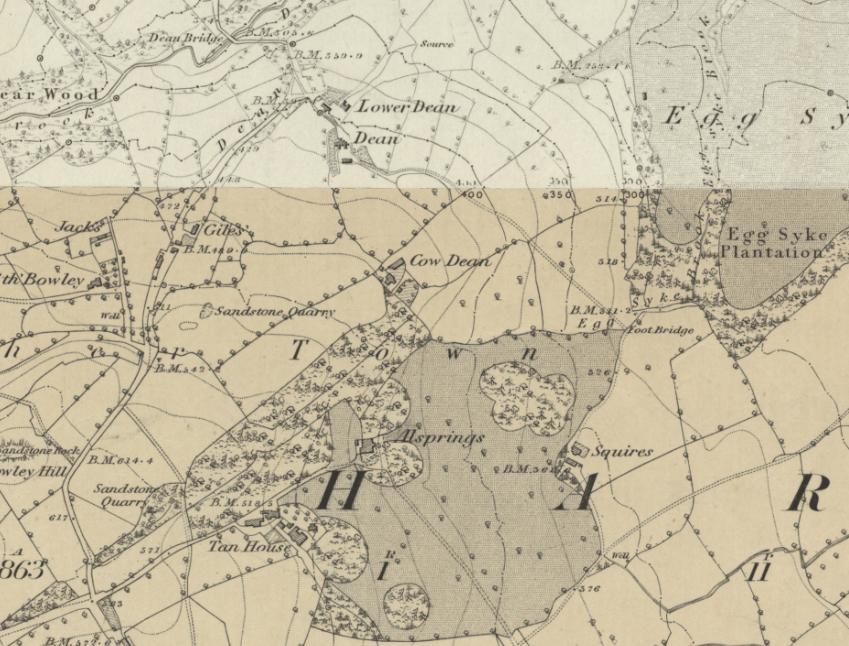
There have been many alterations to the house over the years; around 1990 a porch was removed and a datestone found with the inscription ‘William and Phoebe Mercer 1729‘. This could mean either that the house now standing was built in 1729 totally replacing an earlier structure or that substantial renovations had taken place, however crucks were found during the renovations. Building with crucks may have continued in Lancashire until about 1725, but descriptions of the house gleaned from the inventories suggest a much earlier date. There is a large ingle nook fireplace in what was probably the hall of the house and the layout of the house and the site of the hearth suggests that the Hearth Tax of 1666 showing only one hearth was correct and not an indication of avoidance, which may also point to an early construction date. There is a large barn standing near to the farmhouse that was built no later than 1709, a beam in the barn bears the inscription ‘John Mercer 1709’.
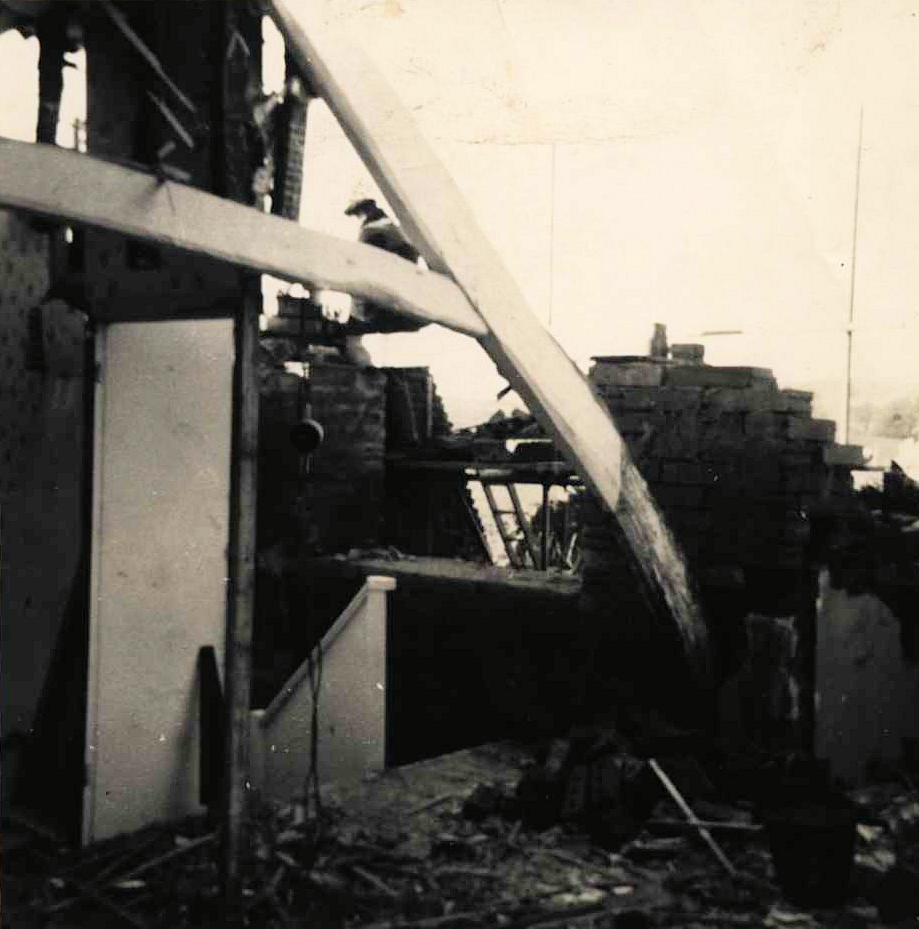
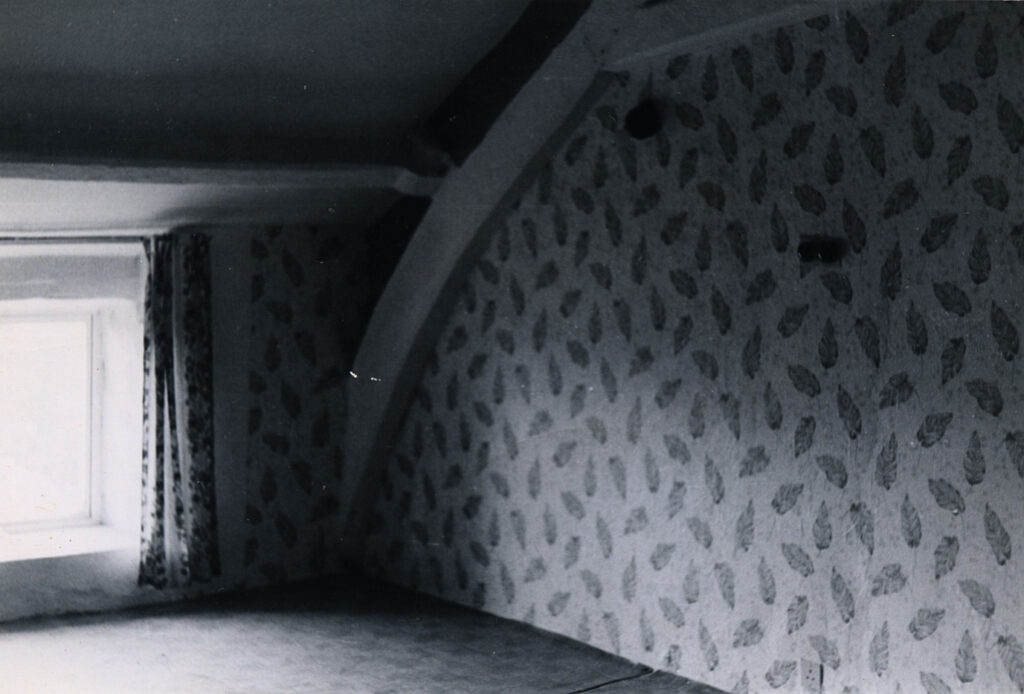
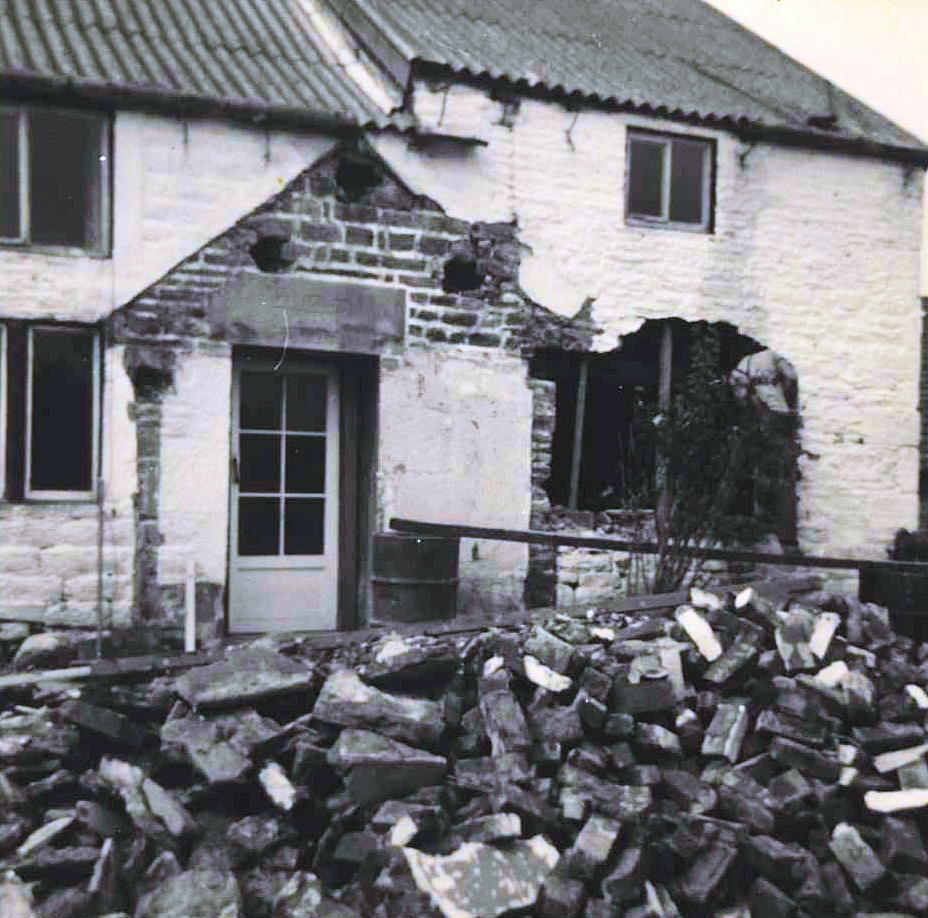
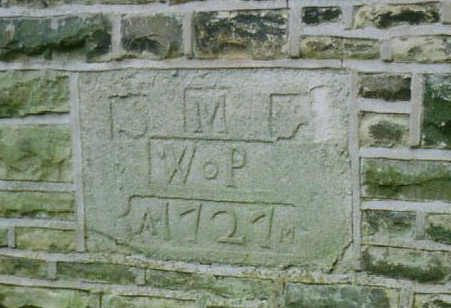
Farms that share, or would previously have shared, a border with Cowden are Bowley, Dean, (now Bowley Scout Camp) Tan House, (now separated from Cowden by private housing) Egg Syke and Squires. Of these Cowden, however, has the distinction of having the earliest mention in the parish register. It also has the distinction that many of the wills made by the inhabitants of the farm have survived.
William’s will of 1613 and the inventory of his goods are possibly the earliest that can be linked to an actual place in Great Harwood. He called himself a yeoman, a title often accorded to those who owned land, but although no leases relating to Cowden have been found the will of his great-grandson, John, states that the land was held from the Hesketh family, who were lords of two thirds of Great Harwood including most of the Upper Town where Cowden is situated. It is probable that the status he gave himself comes from his relative wealth and standing within the community. It seems his peers accorded him even greater status than he did himself for although the introduction by the appraisers to his inventory gives his status as yeoman within the inventory he is named as Mr. William Mercer, a title usually reserved for gentlemen.
The parish registers of Great Harwood have survived from 1547, but entries give little detail and many may be missing; it is difficult to draw many conclusions from the registers much before the middle of the following century. Who was William Mercer? In his will he names his wife Elizabeth, his brother Thomas Mercer and his sister Alice, wife of Roger Feilden. There is a marriage to an Elizabeth Mercer in February 1584/85 which could be his marriage, but this is not certain.
William’s goods and chattels were valued at £256 2s 2d in the inventory taken after he died. The largest proportion of this was in farming stock – livestock accounting for £79. Corn and hay were valued at £34, the inventory was made not long after harvest therefore the barns would be full and the presence of ‘sacks and winnowing cloths’ indicate that this was grown at Cowden or nearby. Debts owed to William came to £66 9s, the largest of these was £30 owed by John Mercer, probably his son, and Roger Fielden who owed £10 was his brother-in-law. William’s household goods show that his family enjoyed a degree of comfort; the total for all household items was £48 12s 3d. Beds and bedding account for £18 13s 3d of this but no other items of obvious luxury are listed. His clothing is worth £2, which is not excessive, but in silver spoons, gold and money he has £13 17s 8d. The gold he left to specified family members. Significantly, for the time and place where woollen cloth production was an important part of the economy, with many families, although primarily engaged in agriculture also producing cloth, there are no looms listed in the inventory. However, textiles do appear in the inventory; the largest part of this is wool worth £11 4s. Linen, canvas yarn and flax are also listed. Textile implements listed are spinning wheels, cards and a heicle. William had been, while not wealthy, certainly very ‘comfortable’.
William Mercer would appear to have practised mixed farming with cattle heavily represented but also a good stock of corn. He had wool valued at £11 4s, while later in the century John Cunliffe, who called himself ‘clothier’ had 10 stones and a half of wool valued at £6 8s 3d. Wool prices may have changed, but it is clear that Williams’s stock of wool was an important part of the economy of the farm. The amount of wool (well after shearing time) and tools for the early stages of textile preparation suggest that William and his family were producing wool for sale and possibly also preparing yarn from this to sell. A plan of Great Harwood made in 1603 shows the road network of the area with the roads to both Manchester and Halifax clearly marked. Both these were centres of the cloth trade and show that these routes were of importance to local wool producers.
In his will William Mercer named his children: John, Christopher, Edward, Grace and Jennet. Of these, the eldest, John, born at Cowden in 1591, inherited the tenancy of the farm. It is comparatively easy to trace John and his family in the parish registers as they are often identified by their residence. Although no record of John Mercer’s marriage has been found his wife Margery is named in his will and he must have married at least a short time before 1618 when the birth of his first child, William, is recorded.
John died in 1669 and the inventory of his goods compiled on the 25 of September that year is particularly useful and interesting in that it lists goods at Cowden room by room. These rooms were: the lower chamber, the upper chamber, the loft, the milkhouse, the fire house, and the buttery. The total value of his goods was £140 5s, substantially less than that of his father. The ratio of farming, textile and household and personal goods is also quite different from his father, with most of his worth being invested in agriculture (of which £84 was in cattle) and household goods worth about £14 compared with the £49 11s 4d owned by his father. John possessed almost the same number of sheep as his father, 38, valued at £8 10s, but the amount of wool was only £2. Textile tools do not appear on the inventory, with the possible exception of ‘weights and scales’. This implies that the only involvement in textiles at Cowden was, as in his father’s time, in wool production and selling wool. Life at Cowden would seem to be less luxurious than earlier in the century; all the items listed are functional in character, but of the seven beds listed two are feather beds.
The irregular recording in the parish register of Great Harwood during the years of the Civil War means that the family at Cowden is more difficult to trace at that time. However, wills show that John’s son William married and had children in these years, although these events aren’t recorded in the parish register. William continued to farm at Cowden, but in 1670 his brothers Thomas and Edward acquired the lease of the adjacent Squires Farm and Elizabeth, Alice, Thomas and Edward Mercer, children of John, are all recorded as being ‘of Squires’ at the time of their deaths between the years 1691 and 1726. William himself died in 1692 at Cowden, but no will appears to have survived. However, his brother Edward, being a single man with no children, named many relatives in his will of 1726, including the children of his brother William.
The inventory of John Mercer, son of William , who died in 1700 seems to show that, having a value of £38 5s 8d, the wealth of the main line of this family had declined steadily since the death of his great-grandfather in 1613. John, however, styled himself yeoman in his will, although the appraisers of his inventory did not do so. John states that he is ’seized of and in one Messuage and Tenement comonly called Cowden nock in my owne possession contayneing about twenty-eight acres’.
In his will John Mercer stipulated that his eldest child, William, was to have Cowden in full after the death of Margaret his wife. Both William’s marriage to Phoebe Walmsley in 1707 and the baptism of Alice his daughter in 1711 are recorded as at Cowden in the parish register. Alice, apparently the only child of William and Phoebe Mercer, was baptised in 1711 but does not have, in the Great Harwood register, either a marriage or a burial entry; she was alive around 1735 when she was mentioned as a life on the lease for Cowden in a survey of Great Harwood that year.
William had a sister, Ann, and a brother John. Ann married John Mercer of Higher Fold (most probably of the Tan House line) in February 1708/09, possibly commemorated by John inscribing his name and the year on a beam in the barn. Ann and John Mercer had three children, John, James and Edward. John her brother married Ann Halliwell of Pickup Bank in 1710 and their children Edward and Elizabeth are recorded as born at Pickup Bank; a daughter Ann was born at Cowden in 1716 and died there in 1732. Edward Mercer of Squires, great uncle to William, John and Ann Mercer of Cowden lived to a great age and did not die until 1726 – if the baptism recorded in 1631 was the correct one he would have been about 95 when he died. Edward left over £210 in his will and among the many bequests to individuals and to charity he left legacies to his great niece Ann and her children and to John – to whom he also left the tenancy of Squires Farm. William Mercer of Cowden died in 1752 and in the absence of a suitable heir to take over the tenancy of the farm Cowden now passed to an unrelated family, the Hoyles, and from then the main line of this Mercer family were based at Squires. William’s wife Phoebe is recorded as dying in the Lower Town in January 1770; in the years before her death she is mentioned many times in the Great Harwood poor law records from 1758 until her death when her funeral was paid for by the town.
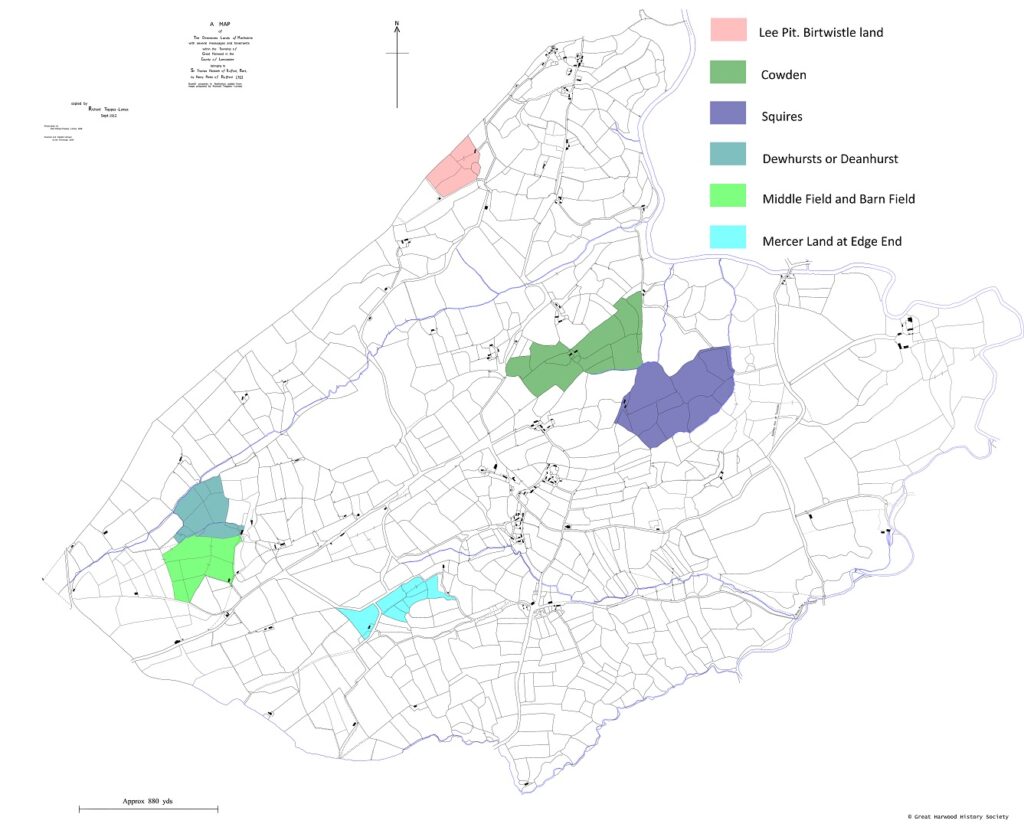
John Mercer who inherited the Squires tenancy from his great uncle died in 1756 and left a will. He had by this time given up the tenancy of Squires in favour of his son Edward and was living at Edge End in Great Harwood. John’s wife Ann had died in 1750 and he had remarried to Mary Croisdale, but it appears the union was not a happy one as he left his goods and the Edge End tenancy to his daughter Elizabeth having already settled Squires on Edward. Mary his wife was said to be ‘at present absent’.
Edward Mercer married Alice Banks at Downham church in 1739. A son Edward was born to them in 1740 in Great Harwood, and they were said to be ‘of Squires’ at that time, but by 1742 they were living in Downham, Edward described as a yeoman, and where sons James, Edward and William were baptised. A lease register of the Heskeths records John Mercer at Squires in 1748, with Edward his son and his grandsons John and James listed in the lease. Squires appears to have been ‘settled’ on Edward, as stated in John Mercer’s will, sometime between the birth of Edward’s sons William in 1749 and the birth of the next child, Thomas in 1754 at Squires.
Enclosure in Great Harwood was piecemeal and by agreement; the document detailing the final processes showing that the enclosure moors and waste had been taking place since 1724. At enclosure, Edward Mercer was awarded Middle Field and Barn Field, the latter close to the tenement known as Dewhurst or Deanhurst and he seems to have lived there rather than Squires for a time as when his daughter Alice died in 1758 she was said to be from ‘Dewhursts near Smalley Thorn’, and a son Richard was recorded at Smalley Thorn when he was born in 1761 and then at Dewhursts when he was buried later that year. A further daughter Alice must have been born to Edward and Alice as she is mentioned in the Nowell Survey of 1765 as being 6 years old – making her birth very soon after the death of the first Alice. There is always the possibility though, that the clerk made an error and the entry for the ‘burial’ was a baptism.
The second son of Edward and Alice was John born about 1740, but for whom no baptism has yet been found. We know of his existence from the lease registers where his age and relationship to Edward is given. The lease registers also state that John was the last life to die and this is his burial entry at St. Bartholomew’s church:
Burial: 7 Apr 1809 St Bartholomew, Great Harwood, Lancashire, England
Jno. Mercer
Age: 68
Abode: Harwood
A survey of Nowell lands was undertaken in 1765 and Edward is shown to have three leases on Nowell land:
Edward Marcer. Lives Alice wife 45, William son 17, Thomas son 12. Land on Harwood Moor – Cunliff Field, Spring Field, Long Lands, Edge Top, Sand Hill, Rent. 11a 3r 26p.
Edward Marcer. Lives Edward son 20, Alice 6 daughter, Mary Birtwistle 26. Land on Harwood Moor: Middle Field and Barn Field. 15a 3r 1p.
The two tenements above were created from the moor or waste, but Edward also had a lease for Dewhursts listed in the 1765 Nowell survey, this was for 12 acres and could possibly be the fields to the north of Middle and Barn Fields.
Mary Birtwistle in the above record was the daughter of Robert Birtwistle, who was also a tenant of Nowell land and one of the lives in the lease for his land was a John Mercer aged 24 – John and Mary married on 7 January 1764. They seem at first to have lived in the Banks area of the town, perhaps with or close to Mary’s family as the first two children are recorded as born at Banks, but the third child was born at Dewhurst in Rowley Dean, the house of his father Edward.
These are the children of John and Mary:
1. Edward Mercer born 1765 at Squires died 1765 at Whalley Banks.
2. Robert Mercer born 1766 at Banks died 1846 at Blackburn.
3. Edward Mercer born 1770 at Dewhursts in Rowley Dean died 1845 in Blackburn.
4. Sarah Mercer born 1772 at Squires.
5. Ann Mercer born 1774 at Squires died 1854 at Lowerfold.
6. Mary Mercer born 1775 at Squires died 1776 at Squires.
7. Thomas Mercer born 1777 probably the Thomas Mercer of Banks who died 1845.
8. David Mercer, twin born 1782 no burial found.
9. Jonathan Mercer, twin born 1782 died 1854 in Billington.
The first Edward died sometime before 1770, but no burial has been found; I can find no certain trace of Sarah after her baptism entry; Mary died as an infant. Of the remaining seven siblings three are mentioned as seeming to be beneficiaries of the will of their grandfather Robert Birtwistle as their names appear in documents relating to Leigh Pit, held by Robert: 1812 Edward Mercer of Brown St Blackburn calico manufacturer, Thomas Mercer of Lee Pit in Harwood cotton weaver, David Mercer of Green Cliff in Harwood shop keeper. Brown Street is adjacent to Syke Street in Blackburn, where Edward and wife Hannah are listed before they died later that decade; Thomas could be the Thomas recorded close to Leigh Pit in 1841 and who died in 1845, but of David there is little trace anywhere in Lancashire after the baptism of his son Henry in Great Harwood in 1818 – I suspect they may have migrated.
This leaves three siblings, Robert, Ann and Jonathan – all of whom stayed in the area and whose lives were interlinked.
Robert Mercer married Mary Smith in 1789 at the Catholic Chapel of Dunkenhalgh. Many online sources, mainly user submitted pedigrees, suggest that the Robert who married Mary Smith first married Ann Noble of Rishton, however this is open to question. The Robert Mercer who married Ann Noble probably was, as these pedigrees often state, the son of Thomas Mercer of Rishton, the Noble family were also mostly located in Rishton. The Robert who married Mary Smith spent much of his life in the Banks area of Great Harwood – close to his brothers. Robert Mercer married Mary Smith in 1789, therefore if Ann Noble was his first wife then she must have been dead, yet when John Smith made his will in 1800 he refers to his granddaughter Ann, wife of Robert Mercer as though she was still alive. Some years later, when Robert married Jemima Morris, the mother of his eighteen children is referred to as his first wife. The balance of probability suggests two separate Roberts here. However, the news report referred to also said his marriage to Jemima should have taken place 36 years before, which would be 1785/86, the year of the marriage of Ann Noble. There are no records of the death in the local area for Ann Mercer wife of Robert before 1789 and seems to be no trace of either of the children of that marriage, Isabella and Mary. However, if the husband of Ann Noble and Mary Smith is indeed the same Robert Mercer it is still apparent that he was the son of John Mercer and Mary of Squires.
Mary Smith was one of the many children of Thomas Smith and Jennet (Giles), a Catholic family, and it seems that Robert had at least agreed for the children of their marriage to be baptised into the Catholic Church and from 1790 to 1805 ten children are recorded at the chapel as of Robert and Mary. However, later Robert states there were eighteen children of the marriage, but records between 1805 and 1815 are patchy and it is possible records have been lost. Therefore, for this study, only these children can be named. It is possible that further research will reveal who the remaining eight children were.
An intriguing insight into the life of Robert Mercer is revealed by his second marriage to Jemima Morris by a newspaper report of the marriage at that time.
“On Tuesday last, at St. John’s Church, Chester, Mr. Robert Mercer, of Henburn Bridge, near Blackburn, to Miss Jemima Morris, of Chester. The parties should have been married 36 years ago. The bridegroom has since been married, and had 18 children by his first wife. He had not seen his present wife for 35 years before Monday last, when he met her at Chester, and married her the following morning.”
Robert and Mary seem to have made their home at Blackburn at some point after their marriage as Jemima died at Grimshaw Park in the town in 1832. A Robert Mercer of the right age is shown living at Keb in Great Harwood with a Thomas Greenwood and wife in the 1841 census, but the death of Robert is recorded in 1846 at Grimshaw Park in Blackburn. The informant on the death certificate of Robert was a Jonathan Smith of 109 Moor Street Blackburn. Jonathan Smith was the son in law of Robert Mercer, having married his daughter Ann – who was his first cousin. Jonathan Smith’s parents were John Smith and Ellen (Holden) and John was the brother of Mary, Robert’s wife and Ann’s mother.
Of all the children of Robert and Mary three are relatively easy to trace:
John Mercer, eldest child of Robert and Mary was born in 1790. He married Jane Richley and they settled at Whitecarr in Great Harwood and raised a large family there.
Alice Mercer, born in 1798, had a child before she married named Robert Mercer, but who was most probably the son of her soon to be husband, Henry Baron. The couple went on to raise a large family in the Lower Town of Great Harwood.
Jonathan Mercer, born in 1800, married first Isabella Marsden and secondly Ellen Duxbury. He, and his family settled in Blackburn.
Ann Mercer, born 1774 daughter of John and Mary also became part of the Smith family marrying Henry Smith, the brother of the Mary who married her brother Robert. Ann was six or seven years the senior of Henry, and throughout her life she endeavoured to trim a few years from her age in official documents.
More information about the Smith family of Great Harwood can be found here.
The remaining sibling, Jonathan Mercer, twin brother of David, didn’t stray far from the family home making his home first at Whalley Banks in Harwood, then from around 1825 just over the border in Billington, in fact at Bridge End just over the Calder from Whalley. In three instances when his children are baptised, he gives his occupation as ‘cotton manufacturer’ or in two instances just ‘manufacturer’. This would most usually mean someone engaged in more than simply weaving, perhaps the owner of a factory, even if small scale – but there is little evidence for this in the case of Jonathan. He features in several news reports and quarter sessions records from 1813 to 1840 for a variety of reasons: receiving stolen goods, being called as a character witness in a murder trial, debtors court and claiming wages fraudulently. Jonathan accompanied his brother Robert to Cheshire when Robert went there to marry his second wife, Jemima, in 1821 and he persisted in calling himself a ‘cotton manufacturer’ in the licence application.
There are many people and lines of descent for the Mercer family of Cowden that this essay has not explored and that are beyond the scope of the study, but which remain for those who suspect they are connected to investigate in greater detail. However, the lines from John Mercer and Mary Bertwistle have known descendants and probably many more to be found.
Mercer of Cowden Family Trees
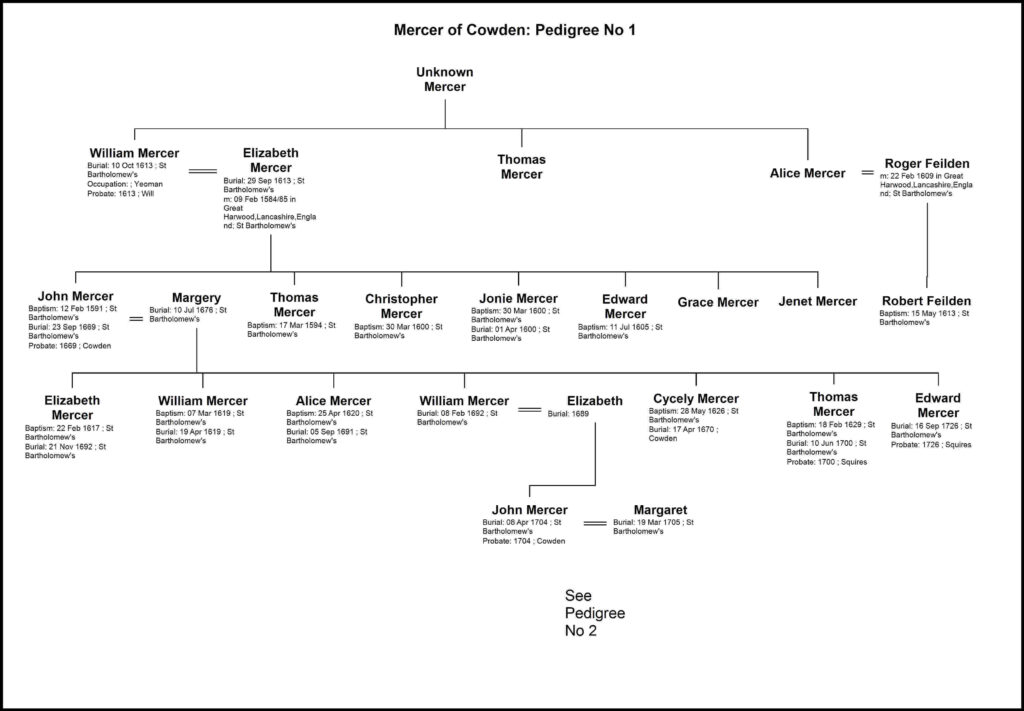

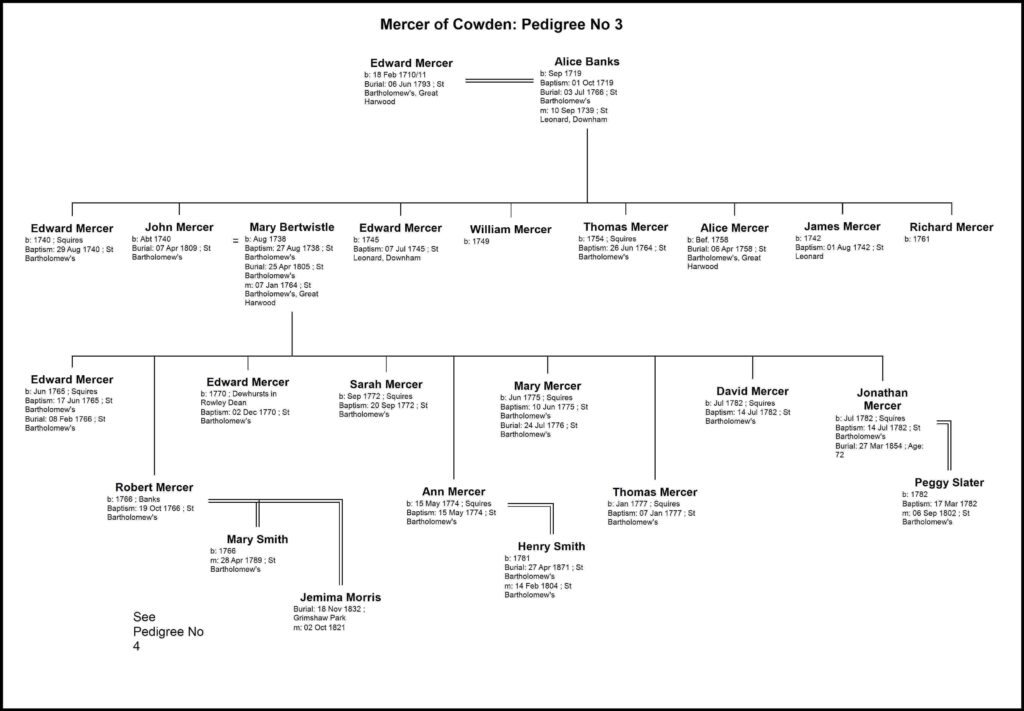
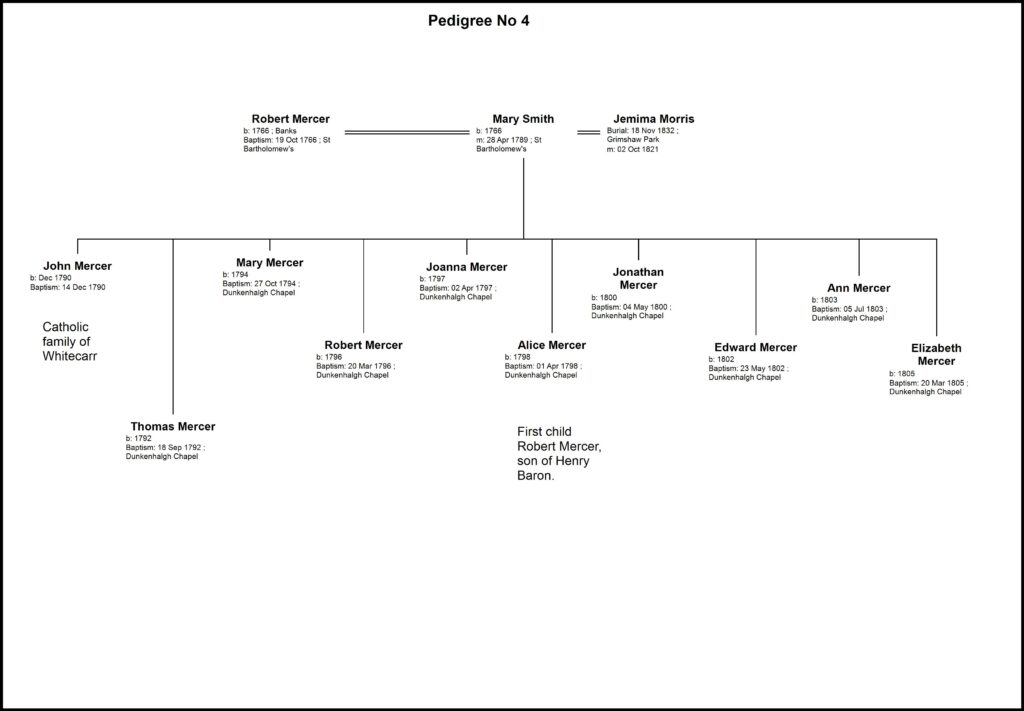
© B. Youds 2020
Documents and Sources Consulted
Primary sources:
1764 Lomax Estate Lease Register Lancashire Archive DDLX/9
Mercer, Edward
1726
a The Will of Edward Mercer Lancashire Archive
WCW/Mercer, Edward/1727
Mercer, Edward
1726
b The Inventory of Edward Mercer Lancashire Archive
WCW/Mercer, Edward/1727
Mercer, John
1669
a The Will of John Mercer Lancashire Archive
WCW/Mercer, John/1669
Mercer, John
1669
b The Inventory of John Mercer Lancashire Archive
WCW/Mercer, John/1669
Mercer, John
1703
The Will of John Mercer of Cowden Lancashire Archive
WCW/Mercer, John/1704
Mercer, John
1704 The Inventory of John Mercer of Cowden Lancashire Archive
WCW/Mercer, John/1704
Mercer, Thomas
1699
The Will of Thomas Mercer Lancashire Archive
WCW/Mercer, Thomas/1702
Mercer, Thomas
1700 The Inventory of Thomas Mercer Lancashire Archive
WCW/Mercer, Thomas/1702
Mercer, William
1613
a The Will of William Mercer Lancashire Archive
WCW/Mercer, William/1613
Mercer, William
1613
b The Inventory of William Mercer Lancashire Archive
WCW/Mercer, William/1613
1762 Plan of Great Harwood Moor
Lancashire Archive
Trappes-Lomax papers
DDLX
Secondary sources:
Great Harwood
1666 Hearth Tax
Transcribed from the original held at the Public Record Office Great Harwood Library
Great Harwood, St. Bartholomew’s Church
The parish register of Great Harwood, 1547 – 1812 Lancashire Parish Register Society
Also accessed online via Ancestry.com
Milward, R
1986 A Glossary of Household, Farming and Trade Terms from Probate Inventories Derbyshire Record Society
Rogers, C D
1975 The Lancashire Population Crisis of 1623 Manchester University Extra Mural Department
Stocks, G A and Tait, J (eds.)
1921 Dunkenhalgh Deeds 1200 – 1600 Chetham Society
Taylor, C
1983 Village and Farmstead Philip
Taylor, R F
1965 Three Cruck buildings in Lancashire and Cheshire
Thirsk, J
1967 “The Farming Regions of England”
in
The Agrarian History of England and Wales Vol. IV 1500 – 1640
Thirsk, J (ed.) Cambridge University Press
Walton, J K
1987 Lancashire a social history 1558-1939 Manchester University Press
Walton, J R
1990 “Agriculture and Rural society 1730 – 1914”
in
An Historical Geography of England and Wales
Dodgshon, R A, Butlin, R A (eds.) Academic Press
2nd edition
Whitaker T D
1876
A History of the Original Parish of Whalley Routledge
4th ed.
Winchester, A
1993 “Field, Wood and Forest – landscapes of medieval Lancashire”
in
Lancashire Local Studies
Crosby, A G (ed.) Carnegie Publishing